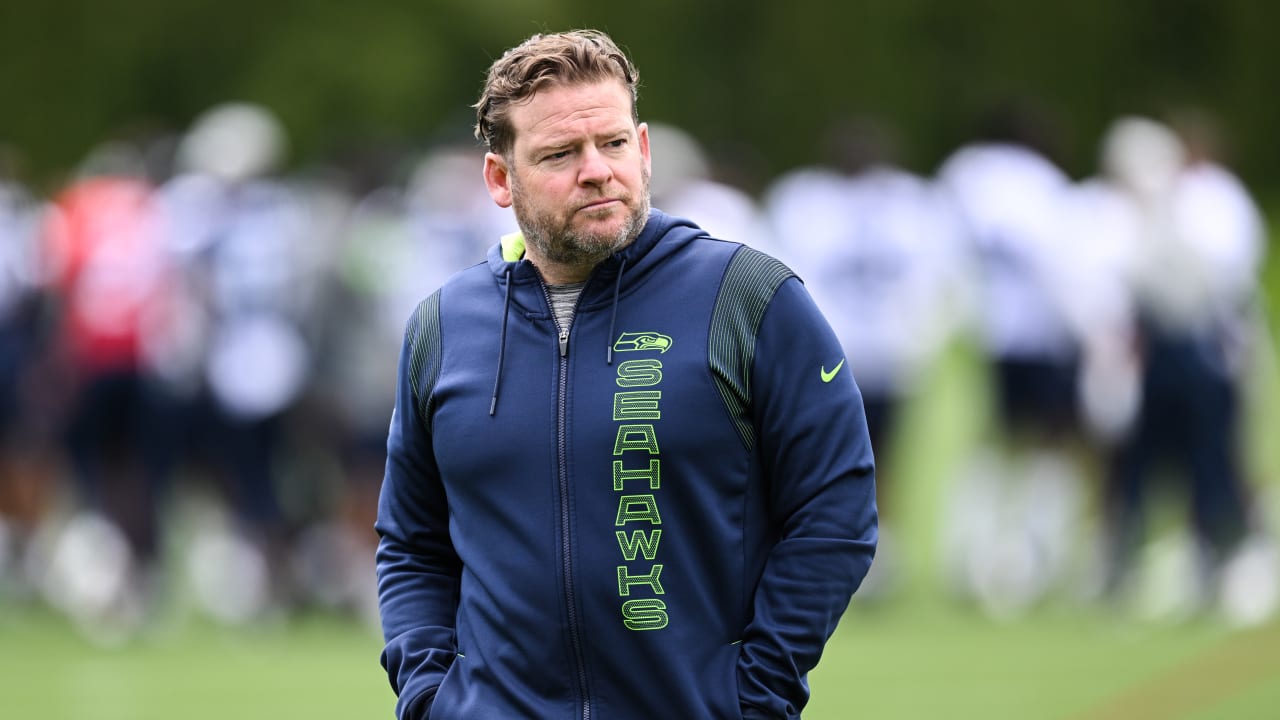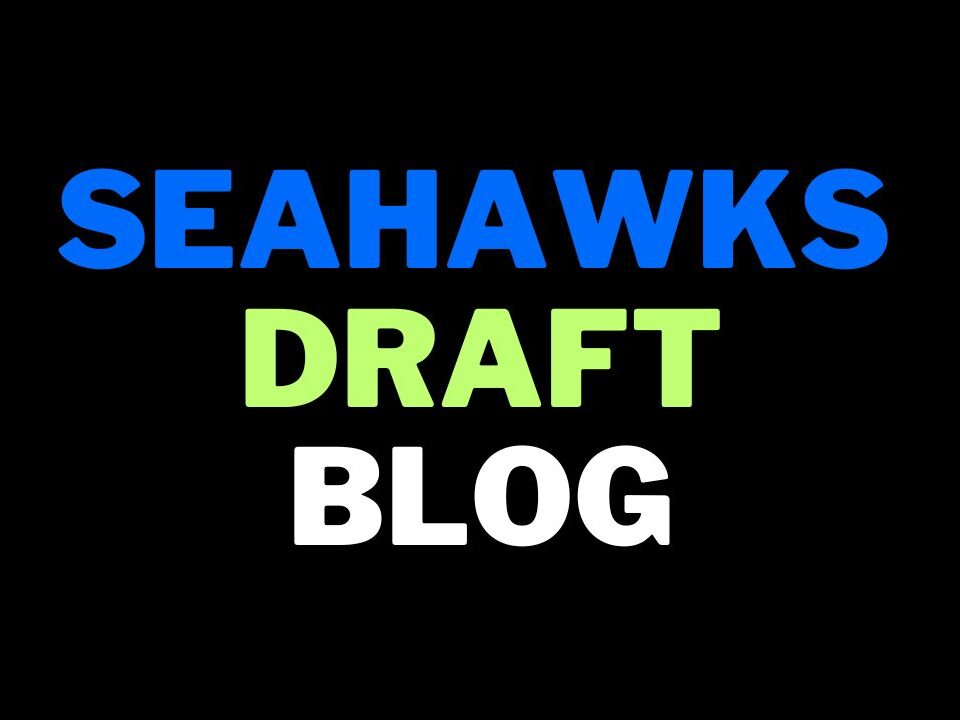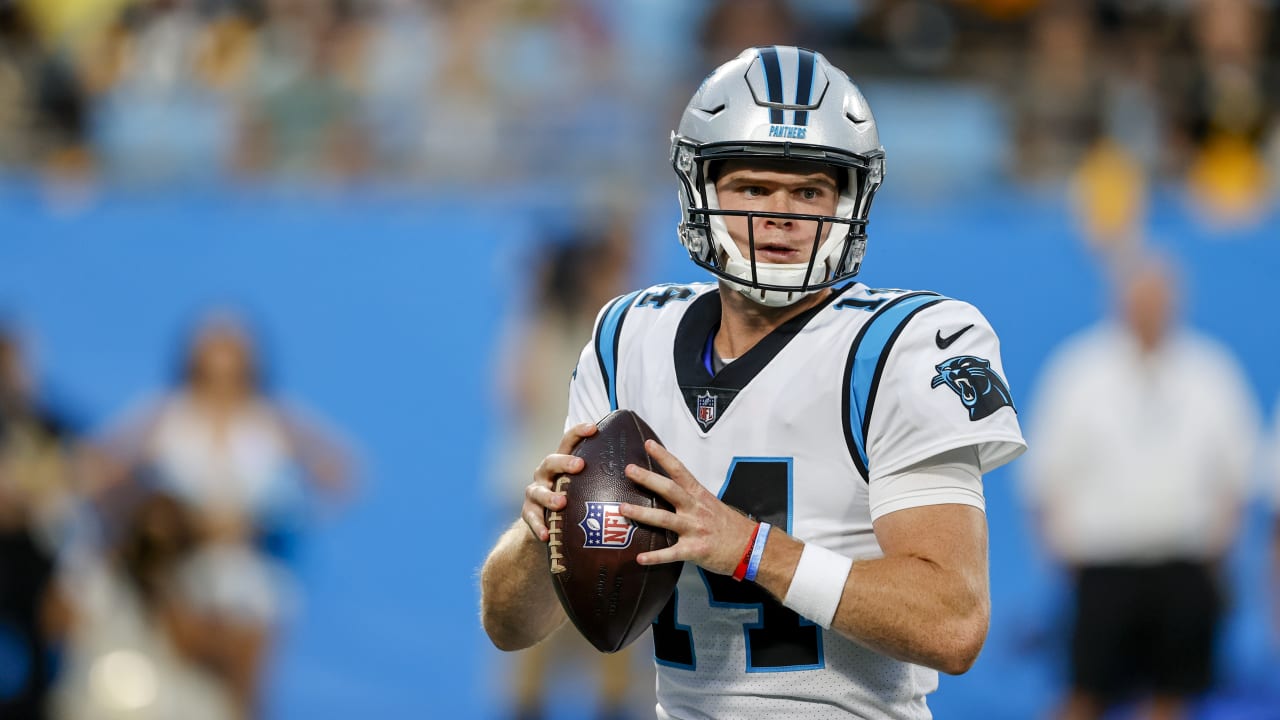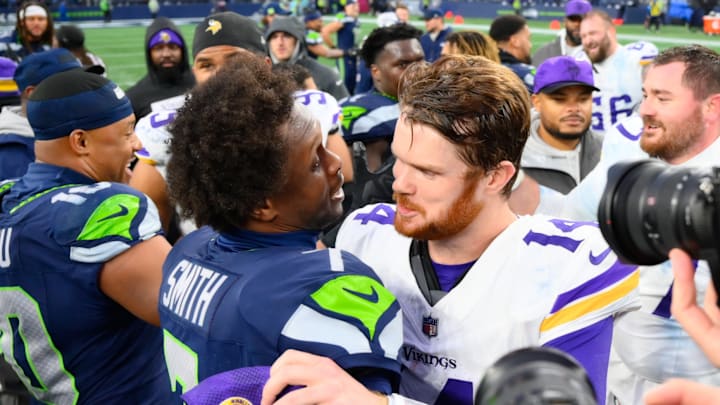
This is a guest article written by Curtis Allen…
Many things have changed for the Seahawks since John Schneider was promoted to Director of Football Operations in January of last year. We have seen adjustments in just about every area of the organization.
One was the hiring of Joey Laine as vice president of football administration in April 2024. He is responsible for the financial side of team operations, including contract negotiations and managing the salary cap. His role is to advise John Schneider on the financial and cap impact of personnel decisions and implement them in a way that best contributes to team success.
Together they have steered away from some of the organizational principles of recent years, adopting an approach I would describe as ‘prudently aggressive.’ They have shifted their focus to a more pragmatic approach and employed that vision to all areas of the roster and cap. It feels more thorough and well-rounded, while also acknowledging the financial realities of running a competitive club in ways the previous administration lacked at times.
Outlining some of these strategies will give us insight into how they may handle decisions in the near term and into 2026 and beyond.
A Direct Approach to Making Necessary Moves
Pete Carroll recently confirmed on an interview with Brock and Salk that after the 2023 season, he and John Schneider were not aligned on what to do next. Carroll wanted to keep the team mostly intact and Schneider felt roster changes were necessary.
Carroll moved on and Schneider stayed. We know what happened next. Safeties Jamal Adams and Quandre Diggs were released. Also notable is that the team did not designate Adams as a post-June 1 cut to split up the dead cap and take some in 2025. The decision was made to take the full $31 million of dead cap in 2024 and start fresh the following year.
That was just one step in this new approach.
Their moves in season revealed another facet of their new mindset. Two of their most prominent offseason acquisitions – linebackers Jerome Baker and Tyrel Dodson – were moved off the roster. Baker was packaged in a trade to bring in Ernest Jones and Dodson was waived. The moves indicated that the leadership felt those two players were not taking the defense in a beneficial direction.
Jones was viewed as a priority acquisition. Mike MacDonald also felt comfortable giving rookie Tyrice Knight more reps and responsibility.
Their instincts proved correct as the two linebackers snapped into place and the defense began to really click as the season wore on.
Baker and Dodson counted another $8 million in dead cap space. But when Schneider and Macdonald determined a change needed to be made, they did not hesitate to eat the dead money. Substantial forward progress and the chance to acquire a potentially long-term piece on defense were a small price to pay for cutting ties with newly acquired players so quickly.
The decisive moves of 2024 were just a warmup for what was to come the following year.
In the offseason, Schneider found himself at odds with Geno Smith and D.K. Metcalf, two of the team’s highest-paid and most visible players. Both were looking for very healthy contract extensions and were disinclined to work with the club on finding mutually beneficial solutions. A stalemate had been reached in early March.
Within a week both were traded to other teams, $34 million in dead cap charges had been absorbed and the Seahawks had signed arguably the best Quarterback in the free agent market to replace Smith.
The organization clearly had spent time in the offseason gaming out scenarios and as a result were able to move very quickly and effectively when they reached a crossroads.
Time will tell if those moves are ultimately successful. Yet the way they made major roster changes in a very short window deserves consideration. Rather than allow two of the team’s biggest pieces to cause distractions with their contract demands and general unhappiness – with all the press and locker room challenges that come with it – the Seahawks moved on and turned those roster assets into draft picks right in the heart of a very deep draft pool.
Look at the Kirk Cousins situation in Atlanta. The Trey Hendrickson situation in Cincinnati. Now imagine the Seahawks having both of those levels of distraction combined on one club. Players and coaches shrug off these types of issues all the time but make no mistake – it can affect the organization from top to bottom.
Schneider does not need to imagine it. He lived it with Russell Wilson. He spent a whole calendar year with that tension around the team in 2021. When the trade was finally was made in 2022, the front office, the players and fans breathed a sigh of relief after the shock wore off.
Lessoned learned. No more drama than is necessary.
Bigger moves of this nature are evidence of a broader trend they have employed in the last two seasons.
They Are More Comfortable Taking on Dead Cap Charges
Last season the Seahawks carried $58 million of dead cap on their books. So far this year? $67 million and counting. That is a whopping $125 million over the last two seasons, which includes $65 million between Adams, Diggs, Smith and Metcalf alone. It accounts for about 23% of their salary cap in that time frame.
Obviously that is less than ideal. Dead cap space limits your flexibility and forces teams to take chances on cheaper (meaning less experienced and proven) talent to build roster depth.
Collecting dead cap charges does have its merits though and the Seahawks seem far more interested in tapping into them to improve both their short and long-term outlook.
What are some of those merits?
In the case of the two safeties, the issues were clear. Both had been banged up and were in the most expensive years of their contracts. The Seahawks were proven correct to release them when they did, as Diggs only managed to play eight games for Tennessee before succumbing to another injury and Adams only managed 43 snaps between two teams.
The cost to carry both of those players on the roster would have been an astounding $48 million. By releasing both in a pre-June 1 manner, the Seahawks picked up over $17 million in cap room in 2024. By not spreading out the dead cap on Adams, they cleared another $17 million in 2025 cap room.
Given a choice of spending $17 million to improve the team or keeping both and watch as they became comatose cap space the Seahawks made the best call they could and lived with a big dead cap hit.
The merits of collecting $34 million of dead cap space for D.K. Metcalf and Geno Smith are more easily discernable: Almost $42 million in cap space gained and picks #52 and #92 in this year’s draft. Jalen Milroe and the ability to go up and get Nick Emmanwori are the direct results of taking those hits, and it could be argued the Seahawks opened enough cap space to cover the 2025 costs for the bulk of their free agent class. You could also argue that in theory, they opened future cap space that would have been earmarked for Metcalf and Smith extensions. That money could be spent to bring in, say, a major piece to elevate their defense.
And therein lies the rub of dead cap money: if, for instance, those newly acquired players become centerpieces in a new renaissance in Seattle, no one will look back at 2025 and say ‘I really am glad the Seahawks ate $34 million of dead money to make this happen.’ That money fades from memory into history books. It is just part of the business, a tool used to get from here to there. Not that collecting dead cap guarantees future success but it opens more opportunities to strengthen and shape the team in a more productive fashion. Moving on from two very productive and very popular (but unhappy) players gave them that opportunity.
Another area in which the Seahawks have shown some aggression is in their use of void years. Void year money becomes dead cap money when the salaried years of the contract are finished. In essence, teams ‘weaponize’ dead money by using void years to push the cap hits into future seasons. This allows teams much more flexibility in their roster choices. They can add more players in free agency, make an in season trade (a Schneider specialty), or roll over that cap surplus into the following season.
The Sam Darnold contract is an interesting example of this technique. The Seahawks added two void years to lower the cap hits for the active years by $4.26 million each year. In 2028 they will have a dead cap hit of $12.8 million.
They also restructured Leonard Williams’ contract and added two void years to free up $14 million. In 2027 they will have a dead cap hit of $9.37 million on the books.
The goal here is obvious: to push cap hits down the road to acquire flexibility now. With the ever-expanding salary cap, using void years in this way is better than an interest-free loan. For instance: $10 million is 3.58% of the current salary cap. In 2026, it will only be a projected 3.38% of the cap. In 2027, 3.21%, and so on. You gain room just by pushing out money.
It also provides a unique option: you could pay down your dead money in the future if you roll those savings forward instead of spending it. Let me explain. In August of 2023, the Seahawks restructured Jamal Adams’ contract to pick up $6.6 million in cap room. They ended the season with $4.67 million in space, so they rolled that over to 2024. If you want to consider that $4.67 million as money solely gained from Adams’ restructuring, they had a little more cap room to handle the $20 million in dead cap they accrued when they cut Adams loose.
Same with D.K. Metcalf. In 2024, they restructured his contract to pick up $9.5 million but they ended the year with a surplus of $8.4 million and rolled that into 2025. You could consider that a paydown of the $21 million in dead cap they took when they traded Metcalf.
Void years in contracts are becoming increasingly popular in the NFL. Per OTC the league currently has over $2.2 billion in void year money on the books. It is here to stay until a new Collective Bargaining Agreement is forged in 2030. Void years are now so ubiquitous that they are like having a quarterback who can use his legs to gain yards rushing or keep plays alive. Years ago? A novelty. Now? They are practically a necessity to remain competitive in the league.
If I had to guess, I would say that Schneider and the Seahawks will never go to the credit-card maxing lengths that teams like Philadelphia and New Orleans go to. But it does appear the team will regularly utilize void years and the resulting dead cap money when they deem it necessary.
New Contract Structures
The team has not revamped every single new contract they have signed but they have made several moves that signal a change in the way they want to proceed.
Sam Darnold’s contract is very interesting. The Seahawks put void years into the contract right at the outset. Normally they have added void years well into the contract when restructuring to gain cap room. On Darnold’s deal, they worked it into the original contract. As we discussed above, this allowed them some room in the near term to keep adding talent. The $4.2 million in room they ‘picked up’ by using the void years could easily justify the $4 million contract they gave swing tackle Josh Jones or contribute the bulk of Jarran Reed’s $5 million contract.
I doubt they will regularly add void years at the outset very often. Darnold’s contract was $100.5 million and he is a good age (28) so there is justification for massaging the numbers a bit to gain some flexibility.
The most intriguing part of the contract is the way it is structured in 2026. Darnold has a base salary of $12.3 million and a roster bonus of $15 million. Neither of those are fully guaranteed at this point. But if Darnold is on the roster on February 15th, $2.5 million of his base salary guarantees and the roster bonus guarantees. The bottom line is, if Darnold is on the roster on that date, he will be a Seahawk in 2026. The consequences of cutting him after that vesting date would be ugly – a $43.1 million dead cap hit and it would cost an extra $9.2 million against the cap.
In past years the Seahawks have used this provision of fully guaranteeing salary five days into the waiver period to allow them a way to manage their cash flow – the salary that guarantees will be placed into escrow in the year it vests. For all intents and purposes, the salary has been fully guaranteed even if the contract language states otherwise. We have seen them practice this with just about every big contract they have signed over the years. Even ones that fans have found distasteful have had their vesting dates pass and the team has been content to eat that guaranteed salary. This year was no different, as Cooper Kupp, Demarcus Lawrence, Jarran Reed and Ernest Jones all have this provision built into their contracts:

The salary guaranteeing five days into the waiver period is nothing new. The roster bonus is. My guess is that having the vesting date be earlier was a negotiating concession made by the team that recognized they were getting the top free agent quarterback locked down very quickly.
The Seahawks usually have roster bonuses due the fifth day of the new league year – about mid-March. My guess is that Darnold’s team thinks five days into the league year (really seven when you count the legal tampering period) is too late to get back on the market and pick his next team if the Seahawks want to move on. Getting cut in February would be an advantage, as he could survey the market, take meetings and negotiate without any major competition. Unrestricted free agents cannot legally do any of those things until March.
So now we have a fascinating decision date. February 15th, 2026, will lock $17.5 million on Darnold’s contract.
Does that mean that Darnold’s $17.5 million is essentially guaranteed and he and the Seahawks are destined to be together in 2026? Probably.
It is also possible that moving the roster bonus vesting date from March back to February simply means the Seahawks agreed to make their decision sooner rather than later. It is very possible that the amount of money is not ‘handshake guaranteed’ and the team could very well decide to move on. Darnold would surely know this was the case before he signed the contract.
We saw the Seahawks take a slightly different approach to the five-day vesting date earlier this year with Uchenna Nwosu. He had a $6 million salary guarantee that would vest in February but the Seahawks approached him about reworking his contract after two injury-filled seasons and he was receptive. The vesting date passed on the calendar and Brady Henderson confirmed that they had moved it back and that Nwosu was still under contract. In the end, both sides got what they were seeking. Nwosu got a new guarantee of $6.98 million and the Seahawks got some cap relief.
Could the Seahawks be demonstrating that the vesting date is not arbitrary in this one case signal a wholesale change in focus? One contract renegotiation is not conclusive proof but it is possible.
If they decided to move on from Darnold before the vesting date, they would incur a $25.6 million dead cap charge and save $8.3 million on the cap. As we discussed above, if they decide to move on, that dead cap number would not prevent doing what they think is best for the team.
Either way, I think it is safe to say that there will be a lot of eyes on the Seahawks in the days following the Super Bowl to see what they do.
The best-case scenario for everyone involved is for Darnold to have a terrific season and render this discussion moot. He has another $5 million in incentives and earning a good chunk of those would make the decision easy.
Another fascinating change the Seahawks have made is the way they pursue Undrafted Free Agents.
In years past, the Seahawks guaranteed very little money when they signed players after the draft. But in 2024 they guaranteed over $700,000 to their Undrafted Free Agent class, a huge change from the previous season. They got even more aggressive this year, guaranteeing $1.3 million to their newest class.
Here are the top figures, courtesy of Spotrac:

A word on the guarantees for UDFA’s: they are all subject to an offset of sorts. If these players are cut by the Seahawks and catch on with other teams – whether on the 53-man roster or their Practice Squad – the Seahawks’ liability is reduced by an equivalent amount.
Otherwise, these players staying on the Practice Squad for the bulk of the season will cover these guarantees.
In essence, the Seahawks have been able to attract better undrafted players without really overcommitting themselves financially. They are just agreeing to spend money they have already budgeted. It is a smart tactic that might produce some fruitage in time.
To be fair, these players went undrafted for a reason. Last year the Seahawks guaranteed Garrett Greenfield $175,000 and he did not make the team and has bounced around the league a bit. George Holani got a $100,000 guarantee and appeared in five games mostly on special teams.
One area their efforts could be rewarded is at the Cornerback spot. They skipped tendering Restricted Free Agent Josh Jobe (another new strategy) and instead signed him to a contract with some up-front bonus money and incentives. Yet in the draft they did not pick any corners to provide more depth. Zy Alexander and Isas Waxter were two of the first players to be reported as signing with the Seahawks. It is possible that one or both of those could see some action this season and reward the Seahawks’ commitment to them.
The financial approach the Seahawks are using is likely to evolve even further over time. They currently have about $30 million in raw cap space and if they make no further moves but sign the balance of their rookie class and a practice squad, would start the season with about $20-22 million or so. There will be opportunities to make trades or pick up other players as the season wears on. There always are.
We will keep a watchful eye on how they manage the cap and contracts as they enter the second season of this new regime.








